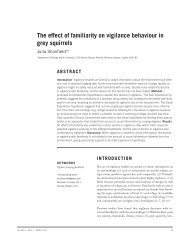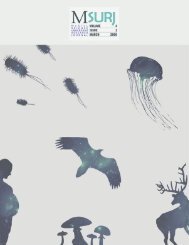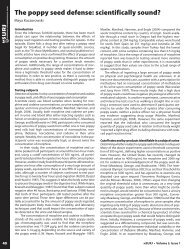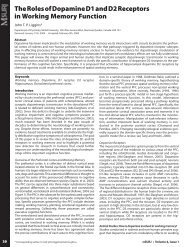the entire issue - McGill Science Undergraduate Research Journal ...
the entire issue - McGill Science Undergraduate Research Journal ...
the entire issue - McGill Science Undergraduate Research Journal ...
You also want an ePaper? Increase the reach of your titles
YUMPU automatically turns print PDFs into web optimized ePapers that Google loves.
Selecting for multicellularity in <strong>the</strong> unicellular Alga Chlamydomonas reinhardtii<br />
Fig. 2:<br />
Plots showing <strong>the</strong> relative<br />
frequency of multicellular<br />
individuals through time. Refer<br />
to Table 1 for strain description.<br />
Study of Paired-Cell Division<br />
The object of this assay was to observe pairs of cells—putatively multicellular<br />
individuals—undergoing division. Synchronized timing of<br />
division within a pair would suggest that <strong>the</strong> individuals are daughter<br />
cells to a common mo<strong>the</strong>r, <strong>the</strong>refore representing a primitive<br />
multicellular state. A sterile screw-top vial containing 3.0ml of Bold’s<br />
minimal medium (agarose 0.9 g/l at 45 °C) was inoculated with 50 μl<br />
of culture from line C1 line, which had by this point demonstrated<br />
<strong>the</strong> clearest trend toward purported multicellularity. The mixture<br />
was plated over solidified Bold’s medium (agar 1.5 g/l), cooled, and<br />
placed open under <strong>the</strong> microscope. Fluorescent lighting in <strong>the</strong> room<br />
plus additional fluorescent and incandescent lamps around <strong>the</strong> microscope<br />
provided ample light for growth. Photographs were taken<br />
hourly when possible. When cleavage initiation was observed, pictures<br />
were taken every 20-30 min. During <strong>the</strong> initial 7 hours of illumination,<br />
photographs of 3 pairs and 2 single cells were taken from <strong>the</strong><br />
20X objective (200X magnification). The plate was left in dim light<br />
overnight with <strong>the</strong> lid on. Twelve hours later, illumination was restored,<br />
and a new group of cells was followed (again with <strong>the</strong> 20X<br />
objective). Once <strong>the</strong> plate was sufficiently dried out, it was possible<br />
to switch to <strong>the</strong> 40X objective (400X magnification). After ano<strong>the</strong>r 10<br />
hours of illumination, <strong>the</strong> room was left in absolute darkness for 24<br />
hours, save for hourly 5 minute breaks for photography. Throughout<br />
this <strong>entire</strong> procedure, <strong>the</strong> stage of <strong>the</strong> microscope was left as<br />
undisturbed as possible so <strong>the</strong> progress of individual cells could be<br />
tracked.<br />
Results<br />
Count Data<br />
The likelihood ratio tests showed significantly higher frequencies<br />
of multicellular individuals in experimental treatments compared<br />
to <strong>the</strong>ir respective controls in <strong>the</strong> ancestral line B2 and all of its descendants<br />
(B3-C4) except for line B4, which showed a significant result,<br />
but was skewed by a replicate which had significantly lower multicellularity<br />
frequencies than <strong>the</strong> control (See Table 2). Of <strong>the</strong> total<br />
individuals classified as multicellular (2-3-4-cell clusters) 88% were<br />
in <strong>the</strong> paired cell form, deviating minimally across strains. Selection<br />
replicates in lines C1 and C2 had <strong>the</strong> highest odds ratios (OR ranges<br />
5.570-17.190 and 3.211-3.881 respectively) indicating a particularly<br />
high frequency of multicellular individuals compared to controls.<br />
Likelihood ratio tests also implicate treatment as a highly significant<br />
factor for <strong>the</strong>se two strains, especially C1. These two strains represent<br />
historically sexually reproducing lines cultured on gel plates.<br />
Weaker responses (though still significant) were observed in C3 and<br />
C4 (historically asexual) and B3 and B4 (historically reproduced sexu-<br />
34<br />
<strong>McGill</strong> <strong>Science</strong> <strong>Undergraduate</strong> <strong>Research</strong> <strong>Journal</strong> - msurj.mcgill.ca









